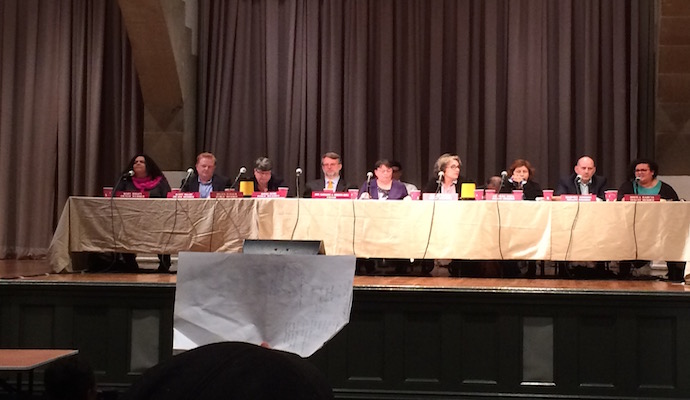In its preliminary vote Tuesday night, the Rent Guidelines Board voted to increase rents between one and three percent for one-year leases and between two and four percent for two-year leases.
The RGB, whose nine members are appointed by Mayor Bill de Blasio, sets rent increase for New Yorkers in rent-stabilized apartments, which make up nearly half of the city’s rental units. Tuesday’s preliminary vote signals a range in which the final increases will fall when the Board votes in June.
The 5-4 decision represents a setback for tenant advocates, who pushed for a rent rollback, and a muted victory for landlords. Both RGB members representing landlords voted “no” on the range after they proposed increases of four percent for one-year leases and six percent for two-year leases.
In public testimony earlier this month, the Rent Stabilization Association, which represents owners throughout the city, had pushed for similarly higher increases.
“These are the increases that building owners need in order to maintain and operate their buildings for the benefit of their tenants and also for the benefit of the city,” said Jack Freund, the organization’s executive vice president.
The vote, if it holds, also means that stabilized one-year leases will not see a third consecutive rent freeze.
Harvey Epstein, a project director at the Urban Justice Center and RGB member representing tenants, argued the range was “not in line with the data.” His remarks highlight disputes over the statistics the RGB provides each year.
But according to The Real Deal’s analysis of RGB research since 2002, the RGB’s final vote has aligned closely with suggestions set out in its own reports, making this year’s proposed increase consistent with historical trends.
The RGB’s research each year includes various formulas used to calculate the rent increases owners would need in order to maintain a constant level of operating income. These five “commensurate rent adjustments” help inform the Board’s later decision regarding the year’s allowable increases for one- and two-year leases.
Since 2002, the final increase has followed most closely the “traditional commensurate adjustment,” with increases falling 1.13 points on average from the suggestion for one-year leases and 1.42 points on average for two-year leases.
This year’s traditional adjustment calculation determined that landlords should be allowed a four percent increase on one-year leases and a 5.5 percent increase on two-year leases. Tuesday’s vote puts the final increases roughly within range of the average difference.
A final increase outside the historical average would not be unprecedented, though. In the last 15 years, the largest differences between the traditional commensurate and the actual increase for one-year leases came in 2003 and 2014, where the differences were 5.9 and 2.8 points, respectively.
Unlike the three other commensurate adjustments, the traditional adjustment takes into account the projected changes in operating costs for the following year. It does not adjust for inflation, however, nor does it “consider the mix of one- and two-year lease renewals,” according to the RGB’s report.
The commensurate adjustments are among many housing and economic data points the RGB take into account, and members may draw different conclusions from the same numbers.
“Everyone on the Board would put different weight on different factors,” said Epstein before Tuesday’s vote.
Epstein said he looks at measures of building income and expenses, as well affordability for tenants. According to data provided by the U.S. Census Bureau, over half of the city’s renters are considered rent burdened, with the median renter in 2015 paying 32 percent of their income in rent, down only slightly from the previous year. Homelessness rates have also risen for an eighth straight year in 2016, an RGB report shows.
The RGB’s final vote is scheduled for June 27 and will apply to leases renewed between Oct. 1, 2017 and Sept. 30, 2018.
(To see a ranking of NYC’s top rental owners, click here)
